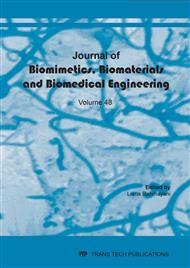[1]
Reddy S, Prasad M.G.S, Savita Singh, Krishnanand. P, Nirjhar Bhowmik, Ashwini. N. Enhancing palatal wound healing by using platelet rich fibrin membrane as fibrin bandage. Int J Appl Dent Sci 2015; 1(4): 2-4.
Google Scholar
[2]
Van Beurden HE, Von den Hoff JW, Torensma R, Maltha JC, Kuijpers-Jagtman AM. Myofibroblasts in palatal wound healing: Prospects for the reduction of wound contraction after cleft palate repair. J Dent Res 2005; 84(10):871-80.
DOI: 10.1177/154405910508401002
Google Scholar
[3]
Kaur G, Utami NV, Usman HA. Effect of topical application of binahong (Anredera cordifolia (Ten.) Steenis) leaf paste in wound healing process in mice. Althea Med J 2014; 6-11.
DOI: 10.15850/amj.v1n1.289
Google Scholar
[4]
Yuliani S.H. Fudholi A, Pramono S, Marchaban. The effect of formula to physical properties of wound healing gel of ethanolic extract of binahong (Anredera cordifolia (Ten.) Steenis). Int J Pharm Sci Res 2012; 3(11): 4254-9.
DOI: 10.1063/1.4958594
Google Scholar
[5]
Astuti SM, Sakinah MAM, Andayani RBM, Risch A. Determination of saponin compound from Anredera cordifolia(Ten) Steenis plant (Binahong) to potential treatment for several diseases. J Agric Sci 2011; 3(4): 224-32.
DOI: 10.5539/jas.v3n4p224
Google Scholar
[6]
Leliqia NPE, Sukandar EY, Fidrianny I. Overview of efficacy, safety and phytochemical study of Anredera cordifolia (Ten.) Steenis. Pharmacologyonline 2017; 1: 124-31.
DOI: 10.22159/ajpcr.2017.v10i12.21503
Google Scholar
[7]
Lin HY, Kuo SC, Chao PL, Lin TD. A New Sapogenin from Boussingaultia gracilis. J Nat Prod 1988; 51(4):797–8.
DOI: 10.1021/np50058a028
Google Scholar
[8]
Pebri IG, Rinidar, Amiruddin. The effect of binahong (Anredera cordifolia) leave extract administration on incision wound healing in rats (Mus musculus). Jurnal Ilmiah Mahasiswa Veteriner 2017; 2(1): 1-11.
Google Scholar
[9]
Miladiyah I, Prabowo BR. Ethanolic extract of Anredera cordifolia (Ten.) Steenis leaves improved wound healing in guinea pigs. Univ Med 2010; 31(1): 4-11.
Google Scholar
[10]
Ardiana T, Kusuma ARP, Firdausy MD. Efficacy of 5% binahong gel (Anredera cordifolia) administration in stimulating fibroblast proliferation in extraction sockets of guinea pigs (Cavia cobaya). ODONTO Dental Journal 2015; 2(1): 64-70.
DOI: 10.30659/odj.2.1.64-70
Google Scholar
[11]
Patel VF, Liu F, Brown MB. Advance in oral transmucosal drug delivery. J Control Release 2011;153(2):106-16.
Google Scholar
[12]
Guo S, DiPietro LA. Factors affecting wound healing. J Dent Res 2010; 89(3): 219-29.
Google Scholar
[13]
Porter S. The role of the fibroblast in wound contraction and healing. Wounds UK 2007; 3(1), 33-40.
Google Scholar
[14]
Olczyk P, Mencner L, Komosinska-Vassev K. The role of the extracellular matrix components in cutaneous wound healing. Biomed Res Int 2014; 2014: 1-8.
DOI: 10.1155/2014/747584
Google Scholar
[15]
Reinke JM, Sorg H. Wound repair and regeneration. Eur Surg Res 2012; 49: 35-43.
DOI: 10.1159/000339613
Google Scholar
[16]
Shah B, Seth AK. Textbook of pharmacognosy and phytochemistry, first ed. New Delhi: Elsevier, 2010: 188-190, 232-234, 253.
Google Scholar
[17]
Djamil R, Winarti W, Syamsudin, Rasna M. (2015). Standardization and A-glucosidase inhibitory of extract from Anredera cordifolia leaves. Proceedings of the 9th Joint Conference on Chemistry – Green Chemistry Section 4: Organic Chemistry, 317-321.
Google Scholar
[18]
Rowe RC, Shesky PJ, Owen SC. Handbook of Pharmaceutical Excipient, sixth ed. Washington: Pharmaceutical Press and American Pharmacist Association, (2009).
Google Scholar
[19]
Shalaby LS, Salama AH, Shawkat SM, Fares AE, Hegazi AG. Comparison of the healing potential of propolis and bee venom on surgically induced wound in rat's buccal mucosa. Int J Adv Res 2018; 6(3): 1268-75.
DOI: 10.21474/ijar01/6795
Google Scholar
[20]
Warsito R, Wuryastuti H. Antibodi dan Imunohistokimia. Yogyakarta: Rapha Publisher, (2014).
Google Scholar
[21]
Monroy PLC, Gefte S, Kuijpers-Jagtman AM, Helmich MPAC, Ulrich DJO, Von den Hoff JW, et al. A rat model for muscle regeneration in the soft palate. PLoS ONE 2013; 8(3): 1-8.
DOI: 10.1371/journal.pone.0059193
Google Scholar
[22]
Von den Hoff JW, Maltha JC K-JA. Palatal wound healing: The effects of scarring on growth. In: Berkowitz S, ed. Cleft lip and palate, second ed. Berlin: Springer-verlag, 2013: 301–13.
DOI: 10.1007/3-540-30020-1_20
Google Scholar
[23]
Ying YL, Hernawan I, Hendarti HY. Inhibitory effect of Binahong (Anredera cordifolia (Ten.) Steenis) towards polybacteria of recurrent aphtous stomatitis. Oral Medicine Dental Journal 2011; 3(2): 18-26.
Google Scholar
[24]
Istyastono EP, Yuliani SH. Scarless wound healing gel with Binahong (Anredera cordifolia (Ten) Steenis) leaves extract and celecoxib as the active ingredients. In: AIP Conference Proceedings. American Institute of Physics Inc.; (2016).
DOI: 10.1063/1.4958594
Google Scholar
[25]
Wozniak L, Skapska S, Marszalek K. Ursolic acid – A pentacyclic triterpenoid with a wide spectrum of pharmacological activities. Molecules 2015;20:20614-20641.
DOI: 10.3390/molecules201119721
Google Scholar
[26]
Bergmann C, Akhmetshina A, Dees C, Palumbo K, Zerr P, Beyer C, et al. Inhibition of glycogen synthase kinase-3 induces dermal fibrosis by activation of the canonical Wnt pathway. Ann Rheum Dis 2011;70(12):2191-8.
DOI: 10.1136/ard.2010.147140
Google Scholar
[27]
Naika HR, Bhavana S, Da Silva JAT, Lingaraju K, Mohan VC, Krishna V. In silico and in vivo wound healing studies of ursolic acid isolated from Clematis gouriana against GSK-3 beta. Nusantara Bioscience 2016;8(2):232-44.
DOI: 10.13057/nusbiosci/n080216
Google Scholar
[28]
Kottaimuthu R, Malaisamy M, Ramasubbu R. A new distribution record of Anredera cordifolia (Basellaceae) from high wavy mountains, Western Ghats. J Biosci Res 2012; 3(3):142-4.
Google Scholar


